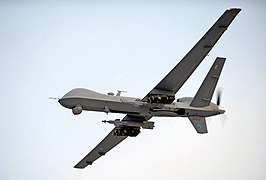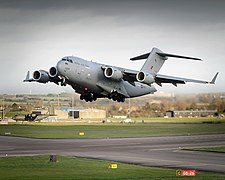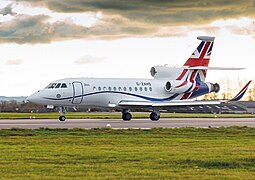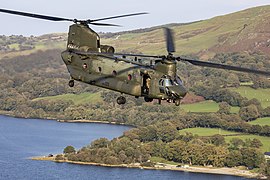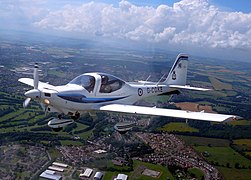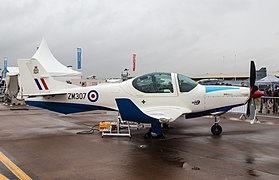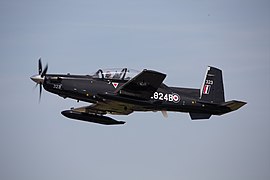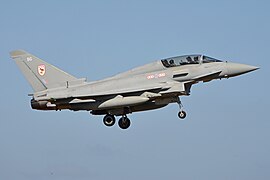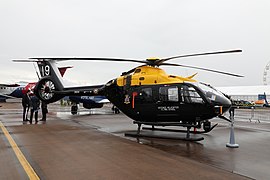Royal Air Force
- Afrikaans
- العربية
- Aragonés
- Asturianu
- Azərbaycanca
- বাংলা
- Български
- Bosanski
- Brezhoneg
- Català
- Čeština
- Cymraeg
- Dansk
- Deutsch
- Eesti
- Ελληνικά
- Español
- Esperanto
- Euskara
- فارسی
- Français
- Frysk
- Galego
- 한국어
- हिन्दी
- Hrvatski
- Bahasa Indonesia
- Italiano
- עברית
- Jawa
- ქართული
- Latviešu
- Lietuvių
- Magyar
- मराठी
- Bahasa Melayu
- Nederlands
- 日本語
- Norsk bokmål
- Norsk nynorsk
- پنجابی
- Polski
- Português
- Română
- Русский
- Scots
- Simple English
- Slovenčina
- Slovenščina
- کوردی
- Српски / srpski
- Srpskohrvatski / српскохрватски
- Suomi
- Svenska
- ไทย
- Тоҷикӣ
- Türkçe
- Українська
- اردو
- Tiếng Việt
- 粵語
- 中文
| Royal Air Force | |
|---|---|
| |
| Colours | Red, white, blue |
| March | Quick: "Royal Air Force March Past" Slow: "Saeculum"[3] |
| Anniversaries | 1 April |
| Engagements | |
| Website | www C-17 Globemaster Envoy IV CC1 |
| Tanker | Voyager KC2/3 |
 |
| Royal Air Force of the British Armed Forces |
|---|
| Components |
|
| History and future |
|
|
| Aircraft |
| Personnel |
| Auxiliary services |
The Royal Air Force (RAF) is the
The RAF's mission is to support the objectives of the British
Today, the Royal Air Force maintains an
History
| Air Force (Constitution) Act 1917 | |
|---|---|
| Act of Parliament | |
 7 & 8 Geo. 5. c. 51 | |
| Dates | |
| Royal assent | 29 November 1917 |
| Other legislation | |
| Amended by | |
Status: Current legislation | |
| Text of statute as originally enacted | |
| Text of the Air Force (Constitution) Act 1917 as in force today (including any amendments) within the United Kingdom, from legislation.gov.uk. | |
Origins
While the British were not the first to make use of heavier-than-air military aircraft, the RAF is the world's oldest independent air force; first air force to become independent of army or naval control.
After the war, the RAF was drastically cut and its inter-war years were relatively quiet. The RAF was put in charge of
The RAF adopted the doctrine of strategic bombing, which led to the construction of long-range bombers and became its main bombing strategy in the Second World War.[20]
Second World War

The Royal Air Force underwent rapid expansion prior to and during the Second World War. Under the

The largest RAF effort during the war was the
Cold War era
Following victory in the Second World War, the RAF underwent significant re-organisation, as technological advances in air warfare saw the arrival of jet fighters and bombers. During the early stages of the Cold War, one of the first major operations undertaken by the RAF was the
Before Britain developed its own
For much of the Cold War the primary role of the RAF was the defence of
In 1957, the RAF participated heavily during the
One of the largest actions undertaken by the RAF during the Cold War was the air campaign during the 1982
Post-Cold War
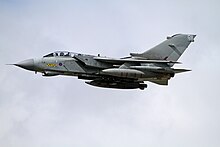
With the end of the Cold War and the collapse of the Soviet Union, the RAF's focus returned to
The RAF began conducting Remotely-piloted Air System (RPAS) operations in 2004, with No. 1115 Flight carrying out missions in Afghanistan and Iraq with the General Atomics MQ-1 Predator.[56] Initially embedded with the United States Air Force, the RAF formed its own RPAS squadron in 2007 when No. 39 Squadron was stood up as a General Atomics MQ-9A Reaper unit at Creech AFB, Nevada.[57]
The RAF's 90th anniversary was commemorated on 1 April 2008 by a flypast of the RAF's Aerobatic Display Team the
Four major defence reviews have been conducted since the end of the Cold War: the 1990
In recent years, fighter aircraft on Quick Reaction Alert (QRA) have been increasingly required to scramble in response to Russian Air Force aircraft approaching British airspace.[63] On 24 January 2014, in the Houses of Parliament, Conservative MP and Minister of State for the Armed Forces, Andrew Robathan, announced that the RAF's QRA force had been scrambled almost thirty times in the last three years: eleven times during 2010, ten times during 2011 and eight times during 2012.[64] RAF Coningsby in Lincolnshire and RAF Lossiemouth in Moray both provide QRA aircraft, and scramble their Typhoons within minutes to meet or intercept aircraft which give cause for concern. Lossiemouth generally covers the northern sector of UK airspace, while Coningsby covers the southern sector. Typhoon pilot Flight Lieutenant Noel Rees describes how QRA duty works. "At the start of the scaled QRA response, civilian air traffic controllers might see on their screens an aircraft behaving erratically, not responding to their radio calls, or note that it's transmitting a distress signal through its transponder. Rather than scramble Typhoons at the first hint of something abnormal, a controller has the option to put them on a higher level of alert, 'a call to cockpit'. In this scenario the pilot races to the hardened aircraft shelter and does everything short of starting his engines".[65]

On 4 October 2015, a final stand-down saw the end of more than 70 years of
In 2018, the RAF's vision of a future constellation of imagery satellites was initiated through the launch of the
Between March 2020 and 2022, the RAF assisted with the response efforts to the COVID-19 pandemic in the United Kingdom as part of Operation Rescript. This saw the service provide repatriation flights and aeromedical evacuations of COVID-19 patients, drivers and call-handlers to support ambulance services and medics to assist with the staffing of hospitals, testing units and vaccination centres.[72][73] Under Operation Broadshare, the RAF has also been involved with COVID-19 relief operations overseas, repatriating stranded nationals and delivering medical supplies and vaccines to British Overseas Territories and military installations.[74]
The UK's 20-year long operations in Afghanistan came to an end in August 2021, seeing the largest airlift since the Berlin Blockade take place. As part of
Structure
Senior leadership
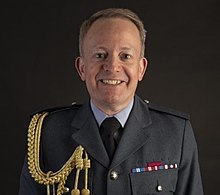
The professional head and highest-ranking officer of the Royal Air Force is the Chief of the Air Staff (CAS). He reports to the Chief of the Defence Staff, who is the professional head of the British Armed Forces.[79] The incumbent Chief of the Air Staff is Air Chief Marshal Sir Richard Knighton who was appointed in 2023.[80]
The management of the RAF is the responsibility of the
The Chief of the Air Staff is supported by several other senior commanders:
| Title | Rank | NATO rank scale |
|---|---|---|
| Chief of the Air Staff | Air Chief Marshal | OF-9 |
| Deputy Chief of the Air Staff | Air Marshal | OF-8 |
| Air and Space Commander | Air Marshal | OF-8 |
| Air Officer Northern Ireland | Air Marshal | OF-8 |
| Assistant Chief of the Air Staff | Air Vice-Marshal | OF-7 |
| Air Officer Scotland | Air Vice-Marshal | OF-7 |
| Assistant Chief of the Air Staff (Plans) | Air Vice-Marshal | OF-7 |
| Chief of Staff Personnel and Air Secretary | Air Vice-Marshal | OF-7 |
| Commandant General Royal Auxiliary Air Force | Air Vice-Marshal | OF-7 |
| Director of Legal Services | Air Vice-Marshal | OF-7 |
| Air Member for Materiel and Chief of Materiel | Vice Admiral
|
OF-8[83] |
Chaplain-in-Chief
|
Air Vice-Marshal | OF-7 |
| Air Officer Wales | Air Commodore | OF-6 |
| Director of Resources | Civilian | |
| Warrant Officer of the Royal Air Force | Warrant Officer | OR-9 |
Air Command
Administrative and operational command of the RAF is delegated by the Air Force Board to Headquarters Air Command, based at RAF High Wycombe in Buckinghamshire. Air Command was formed on 1 April 2007 by combining RAF Strike Command and RAF Personnel and Training Command, resulting in a single command covering the whole RAF, led by the Chief of the Air Staff.[84] Through its subordinate groups, Air Command oversees the whole spectrum of RAF aircraft and operations.[85]
United Kingdom Space Command (UKSC), established 1 April 2021 under the command of Air Vice-Marshal Paul Godfrey is a joint command, but sits "under the Royal Air Force."[86] Godfrey is of equal rank to the commanders of 1, 2, 11, and 22 Groups. The new command has "responsibility for not just operations, but also generating, training and growing the force, and also owning the money and putting all the programmatic rigour into delivering new ..capabilities."[86] UKSC headquarters is at RAF High Wycombe co-located with Air Command.[87]
Groups
No. 1 Group (Air Combat)
No. 1 Group is responsible for combat aircraft (comprising the Lightning Force and Typhoon Force) and the RAF's intelligence, surveillance, target acquisition, and reconnaissance (ISTAR) capabilities. It oversees stations at RAF Coningsby and RAF Waddington in Lincolnshire, RAF Lossiemouth in Moray and RAF Marham in Norfolk. The group's Eurofighter Typhoon FGR4 aircraft protect UK and NATO airspace by providing a continuous Quick Reaction Alert capability.[88]
No. 2 Group (Air Combat Support)
No. 2 Group controls the Air Mobility Force which provides strategic and tactical airlift, air-to-air refuelling and Command Support Air Transport. The group is also responsible for the RAF's Force Protection assets comprising the RAF Regiment and RAF Police. It oversees stations at RAF Benson and RAF Brize Norton in Oxfordshire, RAF Henlow in Bedfordshire, RAF Honington in Suffolk, RAF Odiham in Hampshire and RAF Northolt in West London.[89]
No. 11 Group (Multi-domain operations)
No. 11 Group is responsible for integrating operations across the air, cyber and space domains whilst responding to new and evolving threats. It includes the RAF's Battlespace Management Force which controls the UK Air Surveillance and Control System (ASACS). The group oversees stations at RAF Boulmer in Northumberland, RAF Fylingdales in North Yorkshire and RAF Spadeadam in Cumbria.[90]
No. 22 Group (Training)
No. 22 Group is responsible for the supply of qualified and skilled personnel to the RAF and provides flying and non-flying training to all three British armed services. It is the end-user of the UK Military Flying Training System which is provided by civilian contractor Ascent Flight Training. The group oversees stations at RAF College Cranwell in Lincolnshire, RAF Cosford and RAF Shawbury in Shropshire, RAF Halton in Buckinghamshire, MOD St Athan in the Vale of Glamorgan, RAF St Mawgan in Cornwall and RAF Valley on Angelsey.[91] The No. 22 Group also manages the Royal Air Force Air Cadets.[92]
No. 83 Expeditionary Air Group
Stations

An RAF station is ordinarily subordinate to a group and is commanded by a group captain. Each station typically hosts several flying and non-flying squadrons or units which are supported by administrative and support wings.[94]
United Kingdom
Front-line flying operations are focussed at eight stations:[95]
- RAF Coningsby, RAF Marham and RAF Lossiemouth (Air Combat)
- RAF Waddington (ISTAR)
- RAF Brize Norton and RAF Northolt (Air Transport)
- RAF Benson and RAF Odiham (Support Helicopter Force operating under Joint Helicopter Command)
Flying training takes places at
Operations are supported by numerous other flying and non-flying stations, with activity focussed at RAF Honington which coordinates Force Protection and RAF Leeming & RAF Wittering which have a support enabler role.
A
Overseas
The UK operates permanent military airfields (known as Permanent Joint Operating Bases) in four British Overseas Territories. These bases contribute to the physical defence and maintenance of sovereignty of the British Overseas Territories and enable the UK to conduct expeditionary military operations.[97] Although command and oversight of the bases is provided by Strategic Command, the airfield elements are known as RAF stations.[98]
- Sovereign Base Areas of Akrotiri and Dhekelia, Cyprus)
- RAF Ascension Island (Saint Helena, Ascension and Tristan da Cuhna)
- RAF Mount Pleasant (Falkland Islands)
- RAF Gibraltar (Gibraltar)
Three RAF squadrons are based overseas. No. 17 Test and Evaluation Squadron is based at Edwards Air Force Base, California, in the United States and works in close cooperation with the U.S. Air Force in the development of the Lockheed Martin F-35B Lightning.[99] No. 84 Squadron is located at RAF Akrotiri, operating the Westland Puma HC2 for search and rescue.[100] No. 230 Squadron, based at Medicina Lines, Brunei, also operate the Puma HC2.[101]
Squadrons
A flying squadron is an aircraft unit which carries out the primary tasks of the RAF. RAF squadrons are somewhat analogous to the regiments of the British Army in that they have histories and traditions going back to their formation, regardless of where they are based or which aircraft they are operating. They can be awarded standards and battle honours for meritorious service. Most flying squadrons are commanded by a wing commander and, for a fast-jet squadron, have an establishment of around twelve aircraft.[102]
Flights

Independent flights are so designated because they are explicitly smaller in size than a squadron. Many independent flights are, or have been, front-line flying units. For example, No. 1435 Flight carries out air defence duties for the Falkland Islands, with four Eurofighter Typhoon fighters based at RAF Mount Pleasant.[103]
Support wings and units
Support capabilities are provided by several specialist wings and other units.
|
|
Expeditionary Air Wings
Command, control, and support for overseas operations is typically provided through Expeditionary Air Wings (EAWs). Each wing is brought together as and when required and comprises the deployable elements of its home station as well as other support elements from throughout the RAF.[104]
- No. 34 Expeditionary Air Wing (ISTAR operations[105]
- No. 38 Expeditionary Air Wing (RAF Brize Norton) – air transport operations[106]
- No. 121 Expeditionary Air Wing (RAF Coningsby) – multi-role operations[107]
- No. 135 Expeditionary Air Wing (RAF Leeming) – fighter operations[107]
- No. 138 Expeditionary Air Wing (RAF Marham) – fighter operations[107]
- No. 140 Expeditionary Air Wing (RAF Lossiemouth) – fighter operations[107]
Several Expeditionary Air Wings are based overseas:[93]
- No. 901 Expeditionary Air Wing (Al Udeid Air Base, Qatar) – Communication and information systems support
- No. 902 Expeditionary Air Wing (Middle East) – Helicopter support
- No. 903 Expeditionary Air Wing (RAF Akrotiri, Cyprus) – Supports Operation Shader
- No. 905 Expeditionary Air Wing (Falklands Islands) – Protection of British Overseas Territoriesin the South Atlantic
- No. 906 Expeditionary Air Wing (Middle East) – Air transport support
Training schools
Flying training
The RAF Schools consist of the squadrons and support apparatus that train new aircrew to join front-line squadrons. The schools separate individual streams, but group together units with similar responsibility or that operate the same aircraft type. Some schools operate with only one squadron, and have an overall training throughput which is relatively small; some, like No. 3 Flying Training School, have responsibility for all Elementary Flying Training (EFT) in the RAF, and all RAF aircrew will pass through its squadrons when they start their flying careers. No. 2 Flying Training School and No. 6 Flying Training School do not have a front-line training responsibility – their job is to group the University Air Squadrons and the Volunteer Gliding Squadrons together. The commanding officer of No. 2 FTS holds the only full-time flying appointment for a Group Captain in the RAF, and is a reservist.
- Central Flying School (RAF Cranwell) – standardises flying training across the air force and ensures standards and safety are maintained.[108]
- No. 1 Flying Training School (RAF Shawbury) – basic and advanced helicopter training.[109][110]
- No. 2 Flying Training School (RAF Syerston) – gliding training provided by Volunteer Gliding Squadrons based at airfields throughout the UK.[111]
- No. 3 Flying Training School (RAF Cranwell) – Elementary Flying Training (EFT) for RAF, Fleet Air Arm and Army Air Corps crews, also operates from RAF Wittering and RAF Barkston Heath.[112][113]
- No. 4 Flying Training School (RAF Valley) – Basic Fast Jet Training (BFJT) and Advanced Fast Jet Training (AFJT).[114]
- No. 6 Flying Training School (RAF Cranwell) – Initial training provided by University Air Squadrons and Air Experience Flights based at airfields throughout the UK.[115]
Non-flying training
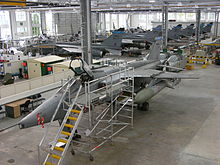
The British military operate a number of joint training organisations, with Air Command leading the provision of technical training through the Defence College of Technical Training (DCTT).[116] It provides training in aeronautical engineering, electro and mechanical engineering, and communication and information systems.[117]
- No. 1 School of Technical Training is based at RAF Cosford and provides RAF personnel with mechanical, avionics, weapons and survival equipment training. Also based at Cosford is the Aerosystems Engineer and Management Training School. Both are part of the Defence School of Aeronautical Engineering.[118]
- No. 4 School of Technical Training is part of the Defence School of Electronic and Mechanical Engineering (DSEME) and is based at MOD St Athan. It provides training to non-aircraft ground engineering technicians.[119]
- No. 1 Radio School and the Aerial Erectors School are based at Cosford and RAF Digby respectively and are part of the Defence School of Communications and Information Systems.[120]
Specialist training and education
The Royal Air Force operates several units and centres for the provision of non-generic training and education. These include the Royal Air Force Leadership Centre and the
Personnel

At its height in 1944 during the Second World War, more than 1,100,000 personnel were serving in the RAF. The longest-lived founding member of the RAF was Henry Allingham, who died on 18 July 2009 aged 113.[124]
As of 1 January 2015, the RAF numbered some 34,200 Regular[125] and 1,940 Royal Auxiliary Air Force[126] personnel, giving a combined component strength of 36,140 personnel. In addition to the active elements of the RAF, (Regular and Royal Auxiliary Air Force), all ex-Regular personnel remain liable to be recalled for duty in a time of need, this is known as the Regular Reserve. In 2007, there were 33,980 RAF Regular Reserves, of which 7,950 served under a fixed-term reserve contract.[127] Publications since April 2013 no-longer report the entire strength of the Regular Reserve, instead they only give a figure for Regular Reserves who serve under a fixed-term reserve contract.[128] They had a strength of 7,120 personnel in 2014.[129]
Figures provided by the International Institute for Strategic Studies from 2012 showed that RAF pilots achieve a relatively high number of flying hours per year when compared with other major NATO allies such as France and Germany. RAF pilots achieve 210 to 290 flying hours per year.[130] French and German Air Force pilots achieved 180 and 150 flying hours across their fleets respectively.[131]
Officers

Officers hold a
To emphasise the merger of both military and naval aviation when the RAF was formed, many of the titles of officers were deliberately chosen to be of a naval character, such as
Other ranks
Other ranks attend the Recruit Training Squadron at RAF Halton for basic training.[134] The titles and insignia of other ranks in the RAF were based on that of the Army, with some alterations in terminology. Over the years, this structure has seen significant changes: for example, there was once a separate system for those in technical trades, and the ranks of chief technician and junior technician continue to be held only by personnel in technical trades. RAF other ranks fall into four categories: Warrant Officers, Senior Non-Commissioned Officers, Junior Non-Commissioned Officers and Airmen. All Warrant Officers in the RAF are equal in terms of rank, but the most senior Non-Commissioned appointment is known as the Warrant Officer of the Royal Air Force.[135]
Ranks
| Royal Air Force officer rank insignia | ||||||||||||
|---|---|---|---|---|---|---|---|---|---|---|---|---|
| NATO code | OF-10
|
OF-9
|
OF-8
|
OF-7
|
OF-6
|
OF-5
|
OF-4
|
OF-3
|
OF-2
|
OF-1
|
OF(D) | |
epaulette rank insignia |
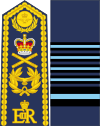
|

|

|
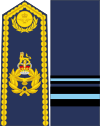
|
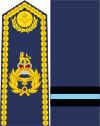
|

|

|

|

|

|

|

|
| rank title[136] | Marshal of the Royal Air Force | Air Chief Marshal | Air Marshal | Air Vice-Marshal | Air Commodore | Group Captain | Wing Commander | Squadron Leader | Flight Lieutenant | Flying Officer | Pilot Officer | Officer cadet
|
| abbreviation | MRAF[note 1] | Air Chf Mshl | Air Mshl | AVM | Air Cdre | Gp Capt | Wg Cdr | Sqn Ldr | Flt Lt | Fg Off | Plt Off | Off Cdt |
| Royal Air Force other rank insignia | ||||||||||||
|---|---|---|---|---|---|---|---|---|---|---|---|---|
| NATO rank code | OR-9 | OR-7 | OR-6 | OR-5 | OR-4 | OR-3 | OR-2 | OR-1 | ||||
rank insignia (view) |

|

|

|

|

|

|

|

|

|

|
no insignia | |
| rank title[137] | Warrant Officer of the Royal Air Force | Warrant Officer | Flight Sergeant | Chief Technician | Sergeant | Corporal | Lance Corporal (RAF Regiment) |
Air Specialist (Class 1) Technician | Air Specialist (Class 1) | Air Specialist (Class 2) | Air Recruit | |
| abbreviation | WORAF | WO | FS | Chf Tech | Sgt | Cpl | LCpl | AS1(T) | AS1 | AS2 | AR | |
rank insignia |

|

|

|
no equivalent | ||||||||
| rank title | RAF Master Aircrew | RAF Flight Sergeant Aircrew | RAF Sergeant Aircrew | |||||||||
| abbreviation | MAcr | FSAcr | SAcr | |||||||||
Aircraft
Current Inventory
| Type | Origin | Class | Role | Introduced | In service | Total | Notes |
|---|---|---|---|---|---|---|---|
| Combat Aircraft | |||||||
| Eurofighter Typhoon | United Kingdom | Jet | Multi-role | 2007 | 137[138] | 137[b][138] | [139] 16 Tranche 1s have been progressively withdrawn and scrapped under the RTP requirement[140] which started in late 2016[141][142] All Tranche 1s to be retired by 2025.[143] |
| Lockheed Martin F-35B Lightning | United States [144] | Jet | Stealth Multi-role | 2013 | 34[c] | 35[d] | [145][146][147][148] Jointly operated with Fleet Air Arm. Maximum of 138 aircraft to be procured[149][150][151][152] |
| AEW&C | |||||||
Boeing E-7 Wedgetail AEW.1 |
United States | Jet | AW&C | 2022 | 0 | 3 | Originally five on order, now reduced to three, to begin operating in 2024.[153][139] |
| Reconnaissance | |||||||
| Beechcraft Shadow R.1 | United States | Propeller | ISTAR | 2009 | 6 | 6 | [139] Expected OSD 2030.[154] A further two aircraft are to be added in 2023 along with an upgrade to the current aircraft[155] |
| Boeing RC-135W Rivet Joint | United States | Jet | SIGINT | 2013 | 3 | 3 | [139] Formally known as Airseeker[156] |
| Boeing P-8 Poseidon MRA.1 | United States | Jet | Anti-ship[157] |
2019 | 9 | 9 | |
| Tanker / Transport | |||||||
| Airbus Voyager | Spain | Jet | Tanker / Transport | 2011 | 14 | 14 | [139] Two additional aircraft available upon request from AirTanker Services |
| Transport | |||||||
| Boeing C-17A Globemaster III | United States | Jet | Transport | 2001 | 8 | 8 | [139] |
| Airbus A400M Atlas C.1 | Spain | Propeller | Transport | 2014 | 22 | 28[e][158][138] | [139] Up to six additional aircraft to be procured by 2030[138][159][160] |
| Dassault Envoy IV CC.1 | France | Jet | Transport | 2022 | 2[161] | 2 | Two aircraft to be introduced from March 2022. To be initially operated under civil contract until 2026[162] |
| Helicopter | |||||||
| Leonardo AW109SP | United Kingdom / Italy | Rotorcraft | Transport | 2016 | 1 | 1 | [139] Used for transportation of senior military commanders or government ministers. [163] |
| Boeing Chinook | United States | Rotorcraft | Transport |
1980 | 57 | 75 | |
| Westland/Airbus Helicopters Puma HC.2 | United Kingdom | Rotorcraft | Transport | 1971 2013 |
14 | 41 | Deployed in Cyprus and Brunei as of 2023[164][139][165] |
Airbus H145 Jupiter HC.2 |
Germany | Rotorcraft | Transport | 2024 | 6 | 6 | Six aircraft ordered; to replace Puma HC2 in Cyprus and Brunei from 2024.[166][167] |
Trainer Aircraft
| |||||||
| Airbus H135 Juno HT.1 | Germany | Rotorcraft | Trainer | 2018 | 29 | 29 | [139] |
Airbus H145 Jupiter HT.1 |
Germany | Rotorcraft | Trainer | 2018 | 7 | 7 | [139] |
| BAE Systems Hawk T.2 | United Kingdom | Jet | Jet trainer | 2009 | 28 | 28 | |
| Beechcraft Texan T1 | United States | Propeller | Trainer | 2018 | 14 | 39 | [139] |
| Embraer Phenom T.1 | Brazil | Jet | Trainer | 2018 | 5 | 5 | [139] |
| Grob Prefect T.1 | Germany | Propeller | Trainer | 2018 | 23 | 23 | [139] |
| Grob Tutor T.1 | Germany | Propeller | Trainer | 1999 | 91 [f] | 119 | [139] Used by the RAF Air Experience Flight. 28 Tutors have been sold to the Finnish Air Force as of 2018 [170] |
| Grob Viking T.1 | Germany | Glider | Trainer | 1990 | 52 | 91 | The Grob Viking T1 is the RAF's primary aircraft for delivering basic glider and flight training to the RAF Air Cadets[139]
|
| Medium-Altitude Long-Endurance UAVs | |||||||
| General Atomics MQ-9A Reaper | United States | UAV | Attack |
2007 | 9 | 10 | [139] Expected OSD 2024. To be replaced by Protector UAV[171][172] |
| Protector RG1 | United States | UAV | Attack |
2023 | 1 | 16 | 16 ordered; first aircraft delivered in September 2023[173] |
RAF Red Arrows
| Type | Origin | Class | Role | Introduced | In service | Total | Notes |
|---|---|---|---|---|---|---|---|
| British Aerospace Hawk T.1 | United Kingdom | Jet | Trainer | 1980 | 12 | 12 | [139] Retired from aggressor role in March 2022;[174] retained by the Red Arrows; to be retired by 2030.[175] |
RAF Battle of Britain Memorial Flight
| Type | Origin | Class | Role | Introduced | In service | Total | Notes |
|---|---|---|---|---|---|---|---|
| Avro Lancaster (PA474) | United Kingdom | Propeller | Heavy bomber | 1942 | 1 | 1 | 1 B.I |
| de Havilland Canada Chipmunk | United Kingdom | Propeller | Trainer | 1946 | 2 | 2 | 2 T.10 |
| Douglas Dakota | United States | Propeller | Transport | 1942 | 1 | 1 | 1 C.3 |
| Hawker Hurricane | United Kingdom | Propeller | Fighter | 1937 | 2 | 2 | 2 Mk IIc |
| Supermarine Spitfire | United Kingdom | Propeller | Fighter | 1938 | 6 | 6 | 1 Mk IIa, 1 Mk Vb, 1 LF.IXe, 1 LF.XVIe, 2 PR.XIX |
Combat air
Typhoon
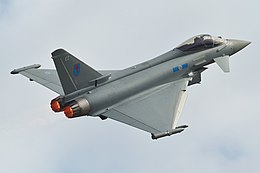
The
The RAF has seven front-line Typhoon squadrons, plus an
The Typhoon made its combat debut in support of
Lightning
The first RAF squadron to operate the F-35B was No. 17 Test and Evaluation Squadron at Edwards AFB, California, accepting its first aircraft in 2014.[99] No. 617 (The Dambusters) Squadron officially reformed on 18 April 2018 as the first operational RAF Lightning squadron.[196] The first four aircraft arrived at RAF Marham from the United States in June 2018,[197] with a further five arriving in August 2018.[198] The Lightning was declared combat ready in January 2019.[199] The second UK based F-35B squadron to be formed was No. 207 Squadron on 1 August 2019 as the OCU for both RAF and Royal Navy pilots.[200][201]
Intelligence, surveillance, target acquisition, and reconnaissance (ISTAR)
Six Hawker Beechcraft Shadow R1s (with two more to be converted) are operated by No. 14 Squadron from RAF Waddington, these aircraft are King Air 350CERs that have been specially converted for the ISTAR role.[202] Four Shadow R1s were originally ordered in 2007 due to an Urgent Operational Requirement,[203] and began the conversion process to the ISTAR role in 2009.[204] ZZ416 was the first Shadow R1 to be delivered in May 2009 to No. V (AC) Squadron.[205] A further Shadow was procured and delivered in December 2011.[206] The Shadow fleet was transferred over to the newly reformed No. 14 Squadron in October 2011.[207] Following the 2015 SDSR, three more Shadows were ordered and the fleet was given an OSD of 2030.[208]
Ten General Atomics MQ-9A Reaper unmanned aerial vehicles have been purchased to support operations in Iraq and Afghanistan. They are operated by No. XIII Squadron at RAF Waddington.[209][210]
Three Boeing RC-135W Rivet Joints (also known in RAF service as Airseeker) replaced the Hawker Siddeley Nimrod R1 fleet in the signals intelligence role under the Airseeker Programme and are flown by No. 51 Squadron.[211] The Nimrod fleet was retired in 2011, the RAF co-manned aircraft of the US Air Force until the three RC-135s entered service between 2014 and 2017.[212] The aircraft were Boeing KC-135R Stratotanker tankers converted to RC-135W standard in the most complex combined Foreign Military Sales case and co-operative support arrangement that the UK had undertaken with the United States Air Force since the Second World War.[213] The Rivet Joint received its first operational deployment in August 2014, when it was deployed to the Middle East to fly missions over Iraq and Syria as part of Operation Shader.[214] The RC-135W's OSD is 2035.[215]
The General Atomics Protector RG1 is currently being introduced into RAF service, with operational flying scheduled to begin in 2025.
Based at RAF Waddington, No. 54 Squadron and No. 56 Squadron act as the OCU and OEU for the ISTAR fleet respectively.[225][226]
Maritime patrol
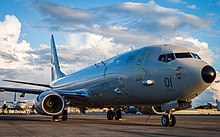
Nine Boeing Poseidon MRA1[227] were ordered by the Government in November 2015 in its Strategic Defence and Security Review for surveillance, anti-submarine and anti-surface ship warfare, filling a capability gap in maritime patrol that had been left since the cancellation of the BAE Systems Nimrod MRA4 programme in the 2010 SDSR.[228] On 13 July 2017, it was announced that No. 120 Squadron and No. 201 Squadron, both former Nimrod MR2 squadrons, would operate the Poseidon and be based at RAF Lossiemouth.[229] No. 120 Squadron was stood up on 1 April 2018,[229] with No. 201 Squadron reforming on 7 August 2021.[230] No. 54 Squadron was the OCU for the Poseidon fleet between 2020 and 2023.[231] No. 42 (Torpedo Bomber) Squadron has been the OCU for the Poseidon since September 2023.[232]
The first production Poseidon MRA1 ZP801 made its initial flight on 13 July 2019.
Air mobility
The Airbus Atlas C1 (A400M) replaced the RAF's fleet of C-130 Hercules, initially replacing the C1/C3 (C-130K) which were withdrawn from use on 28 October 2013, having originally entered service in 1967.[244] Based at RAF Brize Norton, the Atlas fleet is operated by No. 30 Squadron and No. LXX Squadron.[245] The first Atlas C1 (ZM400) was delivered to the RAF in November 2014.[246] Originally, twenty-five A400Ms were ordered in the initial batch; the total initial purchase then dropped to twenty-two.[247][248] The final aircraft in the initial order of 22 aircraft was delivered in May 2023.[158] In February 2023, the Chief of the Air Staff indicated that up to six additional aircraft were planned for delivery by 2030.[138] The C-130 Hercules was retired from RAF service on 30 June 2023.[249]
No. XXIV Squadron acts as the Air Mobility OCU (AMOCU) for the Globemaster and Atlas,[250] while No. 206 Squadron is the OEU.[251]
Air transport tasks are also carried out by the
Two Dassault Falcon 900XLs were procured in early 2022 to replace the RAF's fleet of four BAe 146s (two CC2s and two C3s) in the Command Support Air Transport role.[258] Known as the Envoy IV CC1 in British service, the aircraft are based at RAF Northolt and are operated by a mixed civilian and No. 32 (The Royal) Squadron crew. This arrangement will remain until 2024 when the fleet will be placed on the military register.[259]
-
C-17A Globemaster III
Helicopters
RAF helicopters support the British Army by moving troops and equipment to and around the battlefield. Helicopters are also used in a variety of other roles, including in support of RAF ground units and heavy-lift support for the Royal Marines. The support helicopters are organised into the tri-service Joint Helicopter Command (JHC), along with helicopters from the British Army and Royal Navy.[260] No. 22 Squadron, based at RAF Benson, re-formed in May 2020 as the OEU for JHC.[261]
The large twin-rotor
The Westland Puma HC2 is the RAF's Medium-lift support helicopter. It is operated by No. 33 Squadron and No. 28 (AC) Squadron (Support Helicopter OCU) at RAF Benson.[274] No. 230 Squadron, the RAF's tiger squadron,[275] operate the Puma from Medicina Lines, Brunei, having relocated from RAF Benson in May 2023.[101] No. 84 Squadron based at RAF Akrotiri in the Cyprus Sovereign Base Areas operate three Pumas as an emergency response platform after the Bell Griffin HAR2 was retired in April 2023.[100] The first two Puma HC1s (XW198 and XW199), of an eventual forty-eight, were delivered in January 1971,[276] which were supplemented by a captured Argentine Army SA 330J in 2001 and six ex-South African Air Force SA 330Ls in 2002.[277][278] Twenty-four Puma HC1s underwent upgrades to HC2 standard between 2012 and 2014.[279] The Puma HC2 OSD is currently March 2028, having been extended from March 2025.[280]
Training aircraft
The UK's military flying training has been privatised through a public-private partnership, known as the UK Military Flying Training System (UKMFTS). Training is provided by Ascent Flight Training, a consortium of Lockheed Martin and Babcock International.[281] New aircraft were procured to reduce the training gap between the older generation Grob Tutor T1, Short Tucano T1 and Beechcraft King Air T1 aircraft, and the RAF's modern front-line aircraft, including advanced systems and glass cockpits. UKMFTS also relies far more on synthetic training to prepare aircrew for the front line, where advanced synthetic training is commonplace.[282]
Initial training
The Grob Tutor T1 equips fifteen University Air Squadrons, which provide university students an opportunity to undertake an RAF training syllabus, which includes first solo, as well as air navigation, aerobatics and formation flying. These units are co-located with Air Experience Flights, which share the same aircraft and facilities and provide air experience flying to the Air Training Corps and Combined Cadet Force. The Tutor is also flown by No. 16 Squadron and No. 115 Squadron based at RAF Wittering.[283]
Elementary training
The Grob Prefect T1 was introduced to RAF service in 2016 as its elementary trainer. The 23-strong fleet is based at RAF Cranwell and RAF Barkston Heath in Lincolnshire where they are operated by No. 57 Squadron. On completion of elementary training, aircrew are then streamed to either fast jet, multi-engine, or rotary training.[286]
Basic fast jet training
Basic fast jet training is provided on the Beechcraft Texan T1, which replaced the Short Tucano T1 in November 2019. The Texan is a tandem-seat turboprop aircraft, featuring a digital glass cockpit. It is operated by No. 72 (F) Squadron based at RAF Valley in Anglesey which provides lead-in training for RAF and Royal Navy fighter pilots prior to advanced training on the BAE Hawk T2. The first two Texans were delivered in February 2018 and by December 2018 ten aircraft had arrived at RAF Valley.[287][288] Four additional Texans were delivered on 3 November 2020.[289]
Advanced fast jet training
The BAE Hawk T2 is flown by
On 15 October 2020, it was announced a joint RAF-Qatari Air Force Hawk squadron (similar to No. 12 Squadron) would be formed in the future.[292] On 1 April 2021, it was further elaborated that this squadron would be stood up in September 2021 at RAF Leeming, North Yorkshire.[293] The Joint Hawk Training Squadron received its first two Hawk Mk.167s at RAF Leeming on 1 September 2021.[294] On 24 November 2021, the Joint Hawk Training Squadron became 11 Squadron QEAF when it reformed at RAF Leeming.[295]
Multi-engine training
Multi-Engine aircrew, weapon systems officer (WSO) and weapon systems operator (WSOp) students are trained on the Embraer Phenom T1. It is operated by No. 45 Squadron based at RAF Cranwell. Multi-engine aircrew then go to their Operational Conversion Unit or front-line squadron.[296]
-
Tutor T1
-
Hawk T2
Rotary
No. 1 Flying Training School (No. 1 FTS) (formerly the Defence Helicopter Flying School) is based at RAF Shawbury in Shropshire and provides basic helicopter pilot training for all UK armed forces. It flies twenty-nine Airbus Juno HT1. No. 1 FTS comprises two main elements, 2 Maritime Air Wing (2 MAW) and No. 9 Regiment.[297] 2 MAW includes No. 660 Squadron of the Army Air Corps (AAC) and 705 Naval Air Squadron and provide basic helicopter flying training. No. 9 Regiment comprises No. 60 Squadron of the RAF and No. 670 Squadron of the AAC in the advanced helicopter flying training. No. 202 Squadron is also part of No. 1 FTS and operates the Airbus Jupiter HT1 at RAF Valley.[298]
Future aircraft
In July 2014, the House of Commons Defence Select Committee released a report on the RAF future force structure that envisaged a mixture of unmanned and manned platforms, including further F-35, Protector RG1, a service life extension for the Typhoon (which would otherwise end its service in 2030) or a possible new manned aircraft.[299] In July 2018, at the Farnborough Airshow, the Defence Secretary announced a £2bn investment for BAE Systems, MBDA and Leonardo to develop a new British 6th Generation Fighter to replace Typhoon in 2035 under Project Tempest.[300]
On 22 March 2019, the Defence Secretary announced the UK had signed a $1.98 billion deal to procure five
In March 2021, the Defence and Security Industrial Strategy paper was published which announced the aim to procure a New Medium Helicopter (NMH) in order to replace the Puma HC2, Griffin HAR2 (in RAF service) and the AAC's Bell 212 AH1 and Eurocopter Dauphin AH1.[305] In May 2022, the MoD announced the beginning of the NMH competition, with the aim to acquire up to 44 helicopters.[306] By November 2022, four companies qualified for the MoD's requirements: Airbus (H175M); Boeing (MH-139 Grey Wolf); Leonardo (AW149); and Sikorsky / Lockheed Martin (S-70 Black Hawk).[307] The Minister of State for Defence Procurement opened bidding for the competition, between Airbus Helicopters UK, Leonardo Helicopters UK and Lockheed Martin UK, in February 2024.[308]
-
E-7 Wedgetail
Symbols, flags, emblems and uniform


Following the tradition of the other British armed services, the RAF has adopted symbols to represent it, use as rallying devices for members and promote
The RAF's motto is
The badge of the Royal Air Force was first used in August 1918. In heraldic terms, it is: "In front of a circle inscribed with the motto Per Ardua ad Astra and ensigned by the Imperial Crown an eagle volant and affronté head lowered and to the sinister".[311] Although there have been debates among airmen over the years about whether the bird was originally meant to be an albatross or an eagle, the consensus is that it was always an eagle.[313]
Ceremonial functions and display
Red Arrows

The Red Arrows, officially known as the Royal Air Force Aerobatic Team, is the aerobatics display team of the Royal Air Force based at RAF Waddington. The team was formed in late 1964 as an all-RAF team, replacing a number of unofficial teams that had been sponsored by RAF commands.[314] The Red Arrows badge shows the aircraft in their trademark Diamond Nine formation, with the motto Éclat, a French word meaning "brilliance" or "excellence".[314]
Initially, they were equipped with seven
Royal Air Force Music
Headquarters Royal Air Force Music Services, located at RAF Northolt, supports professional musicians who perform at events around the globe in support of the RAF. The Central Band of the Royal Air Force was established in 1920.[316] Other bands include the Band of the Royal Air Force College, the Band of the Royal Air Force Regiment and the Band of the Royal Auxiliary Air Force.[317]
Trooping the Colour
The Royal Air Force, and its predecessor, the Royal Flying Corps, has provided the flypast for Trooping the Colour since 1913. The RFC performed its first flypast for King George V's Official Birthday over Laffin's Plain, Aldershot.[318]
See also
- List of all aircraft current and former of the United Kingdom
- List of military aircraft operational during World War II
- List of Royal Air Force stations
- Royal Air Force Air Cadets
- Royal Air Force Museum
- RAF News
Footnotes
RAF ranks
- ^ Marshal of the Royal Air Force has become an honorary/posthumous rank, war time rank; ceremonial rank.
Other notes
- ^ Since April 2013, MoD publications no longer report the entire strength of the Regular Reserve, instead, only Regular Reserves serving under a fixed-term reserve contract are counted. These contracts are similar in nature to the Royal Auxiliary Air Force.
- ^ Total inventory, including aircraft in maintenance at any given time
- ^ Includes the 3 used by No. 17(R) squadron based in the US listed below
- ^ Includes the 4 used by No. 17(R) squadron based in the US listed below; also includes one lost in November 2021
- ^ Final aircraft in initial batch delivered May 2023
- ^ As detailed in source this also includes the 5 Tutor platforms which were operated by the Royal Navy, previously categorised as Tutor (RN Flying Grading)
References
- ^ a b "Quarterly service personnel statistics 1 January 2024". Retrieved 12 March 2024.
- ISBN 9781032508955.
- ^ "New official RAF Slow March". Royal Air Force. Archived from the original on 30 January 2022. Retrieved 30 January 2022.
- ^ "First Protector aircraft has arrived at RAF Waddington". raf.mod.uk. Royal Air Force. 23 October 2023. Retrieved 9 December 2023.
- ^ "Royal Air Force". Royal Air Force. Archived from the original on 10 September 2017. Retrieved 15 August 2012.
- ^ "RAF Timeline 1918–1929". Royal Air Force. 2011. Archived from the original on 12 August 2012. Retrieved 15 August 2012.
- ^ Air Power and Colonial Control: The Royal Air Force, 1919–1939 Archived 1 January 2016 at the Wayback Machine By David E. Omissi, Published 1 January 1990, Retrieved 1 February 2014. Page 8.
- ^ BBC: Fact File: The RAF Archived 21 April 2015 at the Wayback Machine, retrieved 1 February 2014
- ^ "RAF in the bombing offensive against Germany". Royal Air Force. Retrieved 4 January 2024.
- ^ a b "Frequently Asked Questions". Royal Air Force. 2011. Archived from the original on 10 August 2012. Retrieved 15 August 2012.
- ^ "Role of the RAF". Royal Air Force. 2011. Archived from the original on 10 August 2012. Retrieved 15 August 2012.
- ^ "Role of Air Power". Royal Air Force. 2011. Archived from the original on 10 August 2012. Retrieved 15 August 2012.
- ^ Nick Harvey, Minister of State for the Armed Forces (31 January 2012). "Military Aircraft". Parliamentary Debates (Hansard). House of Commons. Archived from the original on 17 September 2017. Retrieved 14 April 2019. "House of Commons Hansard Written Answers for 31 Jan 2012 (Pt 0002)". Archived from the original on 17 September 2017. Retrieved 11 September 2017.
- ^ Royal Air Force: Our high-tech gear Archived 3 February 2014 at the Wayback Machine, retrieved 1 February 2014
- ^ "World War I". Royal Air Force. 2011. Archived from the original on 13 August 2012. Retrieved 15 August 2012.
- ^ a b Dickens, Peter (April 2018). "The Royal Air Force's 100th Birthday and its founder – Jan Smuts | The Observation Post". Samilhistory.com. Archived from the original on 7 July 2018. Retrieved 13 July 2018.
- ^ "Plaque: RAF Memorial". London Remembers. Archived from the original on 1 September 2021. Retrieved 1 September 2021.
- ^ Spencer 2020, pp. 62, 63.
- ^ "History of Fleet Air Arm Officers Association, FAAOA". Archived from the original on 18 April 2012. Retrieved 22 May 2016.
- ^ Tami Davis Biddle, "British and American Approaches to Strategic Bombing: Their Origins and Implementation in the World War II Combined Bomber Offensive." Journal of Strategic Studies, March 1995, Vol. 18 Issue 1, pp 91–144; Tami Davis Biddle, Rhetoric and Reality in Air Warfare: The Evolution of British and American Ideas about Strategic Bombing, 1914–1945 (2002)
- ^ "RCAF.com : Archives : RCAF History : The War Years". 21 May 2006. Archived from the original on 11 September 2012. Retrieved 22 July 2017.
- ^ "Explore: 'The Angry Sky'". ww2australia.gov.au. Archived from the original on 11 July 2009. Retrieved 29 October 2015.
- ^ "The Few". The Churchill Centre. March 2009. Archived from the original on 4 March 2012. Retrieved 29 April 2011.
The gratitude of every home in our island, in our Empire, and indeed throughout the world, except in the abodes of the guilty, goes out to the British airmen who, undaunted by odds, unwearied in their constant challenge and mortal danger, are turning the tide of the world war by their prowess and by their devotion. Never in the field of human conflict was so much owed by so many to so few.
- ^ Overy, Richard (2013). The Bombing War. Penguin. p. 322.
- ^ Paul Brickhill, The Dambusters
- ^ "Attack on Amiens Prison, 18th February 1944". RAF. 2004. Archived from the original on 1 January 2007. Retrieved 1 January 2007.
- ^ "RAF Timeline 1945–1949". Royal Air Force. 2011. Archived from the original on 12 August 2012. Retrieved 15 August 2012.
- ^ Aloni 2001, p. 10.
- ^ "Israel v the RAF". Spy Flight. Retrieved 30 April 2023.
- ^ Aloni 2001, pp. 18, 22.
- ^ "RAF Timeline 1960–1969". Royal Air Force. 2011. Archived from the original on 12 August 2012. Retrieved 15 August 2012.
- ^ Burnell, Brian. "Weapon detail and No. 15 Squadron data for 1984." Archived 10 October 2017 at the Wayback Machine nuclear-weapons.info. Retrieved 19 January 2011.
- ^ "Strategic Defence Review 1998: Full Report." Archived 26 October 2012 at the UK Government Web Archive Ministry of Defence, 1998, p. 24.
- ^ "Air of Authority – A History of RAF Organisation – Overseas Commands – Iraq, India and the Far East". Archived from the original on 6 August 2008.
- ^ "Operation Firedog : air support in the Malayan Emergency, 1948–1960". Imperial war Museum. Archived from the original on 31 December 2017. Retrieved 31 December 2017.
- ^ "Seletar's Sunderlands". RAF Seletar. Archived from the original on 14 June 2018. Retrieved 31 December 2017.
- ^ "Flight Lieutenant Jack Sherburn: Pilot awarded a DFC for his gallantry against the Mau Mau who went on to serve in Suez and fly with Yuri Gagarin". The Independent. 20 August 2014. Archived from the original on 1 January 2018. Retrieved 31 December 2017.
- ^ "Suez Crisis". Britain's small wars. Archived from the original on 5 February 2009. Retrieved 31 December 2017.
- ^ "Accident English Electric Canberra PR.7 WH799, 06 Nov 1956". Aviation Safety Network. Archived from the original on 25 May 2021. Retrieved 25 May 2021.
- ^ "Britain's secret wars | Ian Cobain". The Guardian. 8 September 2016. Archived from the original on 6 November 2021. Retrieved 4 November 2021.
- ISBN 9780863567025. Archivedfrom the original on 23 January 2021. Retrieved 29 April 2018 – via Google Books.
- ^ "Confrontation Ends". Straits Times. 12 August 1966. Archived from the original on 31 December 2017. Retrieved 31 December 2017.
- ^ Ritchie 2011, p. 87.
- ^ Ritchie 2011, pp. 86–87, 89, 92.
- ^ Ashworth 1989, p. 26.
- ^ Evans 1998, pp. 74–75.
- ^ "Argentine Aircraft Lost – Falklands War 1982". Naval-history.net. 15 June 1982. Archived from the original on 29 May 2009. Retrieved 23 March 2010.
- ^ "RAF Typhoons arrive for Falkland Islands mission – 9/22/2009". Flight Global. 22 September 2009. Archived from the original on 26 December 2010. Retrieved 19 August 2014.
- ^ Royal Air Force: Expeditionary Air Force Archived 14 February 2014 at the Wayback Machine, raf.mod.uk
- ^ "Gulf War 25th anniversary special: a quick look at the RAF Tornado's reconnaissance missions over Iraq". Aviationist. 17 January 2016. Archived from the original on 31 December 2017. Retrieved 31 December 2017.
- ^ "RAF 'nearly ran out of bombs' in Kosovo". The Guardian. 25 April 2000. Archived from the original on 31 December 2017. Retrieved 31 December 2017.
- ^ Tornados Bound for Kandahar, Air Forces Monthly, August 2008 issue, p. 8.
- ^ "903 Expeditionary Air Wing". Royal Air Force (RAF). Archived from the original on 18 March 2015. Retrieved 21 October 2014.
- ^ "MOD rushes new transport plane into service for operations". The Telegraph. 22 April 2011. Archived from the original on 1 January 2018. Retrieved 31 December 2017.
- ^ Grzeszczyk, Sian (26 September 2022). "Eight years of Operation Shader: The UK's mission against IS". forces.net. Retrieved 24 April 2023.
- ^ "Reaper Takes to the Air". General Atomics. 8 November 2007. Retrieved 2 May 2023.
- ^ Hoyle, Craig (16 June 2008). "UK cheers the Reaper UAV". Flight Global. Archived from the original on 2 February 2023. Retrieved 2 May 2023.
- ^ "90th Anniversary Flypast in London". RAF News Archives. 1 April 2008. Archived from the original on 16 October 2015. Retrieved 30 October 2015.
- ^ "BBC Media Player". Archived from the original on 2 April 2008. Retrieved 22 July 2017.
- ^ "Flypast marks RAF's anniversary". BBC News. Archived from the original on 6 April 2008. Retrieved 29 October 2015.
- ^ "Lots of Losers in U.K. Defense Review". DefenseNews. Retrieved 22 October 2010.[dead link]
- ^ Wilkinson, Tom (24 November 2010). "Last Harrier jet leaves Ark Royal". Independent. UK. Archived from the original on 27 November 2010. Retrieved 4 December 2010.
- ^ RAF Typhoons intercept Russian bombers Archived 19 February 2014 at the Wayback Machine (flightglobal.com), 27 October 2011
- ^ Hansard Archived 14 June 2018 at the Wayback Machine (publications.parliament.uk), 24 January 2014
- ^ UK Ministry of Defence press release 20 September 2012
- ^ "Farewell to RAF UK Search & Rescue". raf.mod.uk. Archived from the original on 8 December 2015. Retrieved 3 November 2015.
- ^ Allison, George (1 March 2018). "Royal Air Force surveillance satellite launched into space". UK Defence Journal. Archived from the original on 3 March 2018. Retrieved 2 March 2018.
- ^ Corfield, Gareth (1 March 2018). "Brit military boffins buy airtime on HD eye-in-the-sky video satellite". The Register. Archived from the original on 1 March 2018. Retrieved 2 March 2018.
- ^ "RAF100". Royal Air Force. Retrieved 2 May 2023.
- ^ "RAF marks 100 years with day of centrepiece celebrations". Royal Air Force. 10 July 2018. Retrieved 2 May 2023.
- ^ "RAF100 Parade & Flypast 2018". military-airshows.co.uk. Retrieved 2 May 2023.
- ^ "COVID Support Force: the MOD's contribution to the coronavirus response". GOV.UK. 12 June 2020. Archived from the original on 22 March 2021. Retrieved 12 August 2021.
- ^ "Tactical Medical Wing Personnel Support NHS During Coronavirus Pandemic". Royal Air Force. 8 March 2021. Archived from the original on 12 August 2021. Retrieved 12 August 2021.
- ^ "Fighting an invisible enemy at home and overseas". Ministry of Defence. 16 July 2020. Archived from the original on 12 August 2021. Retrieved 12 August 2021.
- ^ Bowden, George; Wright, Katie (29 August 2021). "Afghanistan: British ambassador home as last UK troops leave". BBC News. Retrieved 24 April 2023.
- ^ "Afghanistan: Operation Pitting". Imperial War Museum. Retrieved 24 April 2023.
- ^ Seddon, Sean; Cooney, Christy (4 May 2023). "Sudan: Final UK evacuation flight leaves the country". BBC News. Retrieved 16 May 2023.
- ^ Haynes, Deborah (15 May 2023). "UK will be left 'dangerously exposed' when it cuts fleet of special forces aircraft, sources say". Sky News. Retrieved 16 May 2023.
- ^ "Air Command senior, as of September 2018". GOV.UK. Ministry of Defence. 12 March 2020. Archived from the original on 28 July 2020. Retrieved 9 May 2020.
- ^ "Chief of the Air Staff". Royal Air Force. Retrieved 1 July 2023.
- ^ Heyman 2013, pp. 134–135.
- ^ "Senior Commanders". Royal Air Force. Archived from the original on 3 March 2021. Retrieved 8 March 2021.
- ^ Thompson, Richard. "Senior Royal Air Force Appointments". raf.mod.uk. Archived from the original on 5 July 2017. Retrieved 17 March 2021.
- ^ Heyman 2013, p. 136.
- ^ "RAF High Wycombe". Royal Air Force. Archived from the original on 10 September 2017. Retrieved 9 May 2020.
- ^ a b "Q&A: Air Vice-Marshal Harv Smyth talks UK Space Command". Airforce Technology. 23 February 2021. Archived from the original on 27 April 2021. Retrieved 28 April 2021.
- ^ "UK Space Command at RAF High Wycombe – Air Commodore Paul Godfrey to lead". Bucks Free Press. 2 February 2021. Archived from the original on 28 April 2021. Retrieved 28 April 2021.
- ^ "No. 1 Group". Royal Air Force. Archived from the original on 10 September 2017. Retrieved 9 May 2020.
- ^ "No. 2 Group". Royal Air Force. Archived from the original on 10 September 2017. Retrieved 9 May 2020.
- ^ "No. 11 Group". Royal Air Force. Archived from the original on 10 September 2017. Retrieved 9 May 2020.
- ^ "No 22 Group". Royal Air Force. Archived from the original on 10 September 2017. Retrieved 9 May 2020.
- ^ "Royal Air Force". Royal Air Force. Archived from the original on 10 September 2017. Retrieved 12 September 2021.
- ^ a b "No 83 Expeditionary Air Group". Royal Air Force. Archived from the original on 10 September 2017. Retrieved 9 May 2020.
- ^ Heyman 2013, p. 145.
- ^ "RAF Stations". Royal Air Force. Archived from the original on 28 July 2020. Retrieved 10 May 2020.
- ^ "Quick Reaction Alert". Royal Air Force. Archived from the original on 10 September 2017. Retrieved 10 May 2020.
- ^ "Permanent Joint Operating Bases (PJOBs)". GOV.UK. Ministry of Defence. 12 December 2012. Archived from the original on 22 March 2016. Retrieved 19 July 2017.
- ^ "House of Commons – Hansard Written Answers for 17 March 2014 : Column 493W". parliament.uk. 17 March 2014. Archived from the original on 5 March 2017. Retrieved 19 July 2017.
- ^ a b "17(R) Squadron". Royal Air Force. Archived from the original on 28 October 2016. Retrieved 1 April 2019.
- ^ a b Cacoyannis, Xenia Zubova Sofie (4 April 2023). "Start of a new era at RAF Akrotiri as Pumas replace Griffin helicopters in Cyprus". forces.net. Retrieved 25 April 2023.
- ^ a b "RAF Benson – Last week, on the 18th May, 230 Squadron officially re-mustered in Brunei marking its return to South East Asia... | Facebook". RAF Benson (Facebook). 24 May 2023. Retrieved 3 June 2023.
- ^ "RAF Station organisation". Armed forces. Archived from the original on 24 August 2017. Retrieved 31 December 2017.
- ^ "History of 1435 Squadron". MOD. Archived from the original on 22 December 2015.
- ISBN 978-1-78155-635-1. Archivedfrom the original on 18 August 2021. Retrieved 20 November 2020.
- ^ "Number 34 Expeditionary Air Wing". RAF. Archived from the original on 1 January 2018. Retrieved 31 December 2017.
- ^ "A Special Thank You For RAF Personnel Involved in Op Ruman". Forces Network. 27 October 2017. Archived from the original on 2 January 2018. Retrieved 1 January 2018.
- ^ a b c d "RAF Mareham". RAF. Archived from the original on 31 July 2017. Retrieved 31 December 2017.
- ^ "Robert Smith-Barry: The man who taught the world to fly". BBC. 23 February 2013. Archived from the original on 24 October 2018. Retrieved 31 December 2017.
- ^ "Welcome to RAF Shawbury". RAF. Archived from the original on 17 October 2017. Retrieved 31 December 2017.
- ^ "Royal Air Force". Royal Air Force. Archived from the original on 10 September 2017. Retrieved 23 April 2020.
- ^ "New Gliding School Launches for Air Cadets". Air Cadets. Archived from the original on 15 February 2014. Retrieved 14 December 2014.
- ^ "Elementary Flying Training". Royal Navy. Archived from the original on 1 January 2018. Retrieved 31 December 2017.
- ^ "RAF Cranwell". Royal Air Force. Archived from the original on 24 September 2015. Retrieved 23 November 2014.
- ^ "RAF Valley". Royal Air Force. Archived from the original on 28 February 2020. Retrieved 28 February 2020.
- ^ "6 Flying Training School". RAF.mod.uk. Archived from the original on 12 October 2015. Retrieved 8 October 2015.
- ^ "Defence College of Technical Training". RAF. Archived from the original on 30 July 2017. Retrieved 29 July 2017.
- ^ "RAF – Defence College of Technical Training". raf.mod.uk. Archived from the original on 4 February 2017. Retrieved 29 December 2016.
- ^ "RAF Cosford". Royal Air Force. Archived from the original on 10 September 2017. Retrieved 13 February 2021.
- ^ "MOD St Athan". Royal Air Force. Archived from the original on 10 September 2017. Retrieved 13 February 2021.
- ^ here, RAF Details. "RAF – DSCIS". raf.mod.uk. Archived from the original on 30 July 2017. Retrieved 29 July 2017.
- ^ "Royal Air Force Centre for Air Power Studies". Air Power Studies. Archived from the original on 1 January 2018. Retrieved 31 December 2017.
- ^ "Air Warfare Centre". armedforces.co.uk. Archived from the original on 10 February 2012. Retrieved 5 January 2012.
- ^ "Defence Review: inside the college that trains the top brass". Telegraph. 16 September 2010. Archived from the original on 1 January 2018. Retrieved 31 December 2017.
- ^ "Fly-past for Britain's oldest man". BBC News. 3 June 2006. Archived from the original on 30 April 2009. Retrieved 20 April 2011.
- ^ gov.uk MoD – regular personnel Archived 2 April 2015 at the Wayback Machine, table 2-page 8. 1 January 2015.
- ^ gov.uk MoD – quarterly personnel report Archived 21 April 2016 at the Wayback Machine, table 4-page 9. 1 January 2015.
- ^ dasa.mod – reserves and cadet strengths Archived 3 December 2013 at the Wayback Machine, table 4-page 6. April 2012.
- ^ gov.uk MoD – reserves and cadet strengths Archived 8 March 2016 at the Wayback Machine, table 4-page 13. See note 2. April 2014.
- ^ gov.uk MoD – reserves and cadet strengths Archived 8 March 2016 at the Wayback Machine, table 4-page 13. April 2014.
- ^ IISS 2012, p. 171
- ^ IISS 2012, pp. 111–120
- ^ "RAF IOT Breakdown" (PDF). 9 August 2016. Archived (PDF) from the original on 22 October 2016. Retrieved 22 October 2016.
- ^ "Commissioned ranks of the Royal Air Force 1919–present". Air of Authority – A history of RAF Organisation. Archived from the original on 31 December 2017. Retrieved 31 December 2017.
- ^ "Recruit training". RAF. Archived from the original on 1 January 2018. Retrieved 31 December 2017.
- ^ "Warrant Officer of the Royal Air Force". Royal Air Force. Archived from the original on 21 October 2021. Retrieved 11 October 2021.
- ^ "RAF Ranks". RAF.MoD.uk. Royal Air Force. n.d. Retrieved 29 August 2023.
- ^ "RAF Ranks". RAF.MoD.uk. Royal Air Force. n.d. Archived from the original on 6 August 2023. Retrieved 29 August 2023.
- ^ a b c d e "Oral evidence: Work of the Chief of the Air Staff, HC 1108". 1 February 2023.
- ^ a b c d e f g h i j k l m n o p q r s "UK Armed Forces Equipment and Formations 2022". Gov.uk. Ministry of Defence. 11 October 2022.
- ^ "RAF to scrap twin-seat Typhoons - Jane's 360". www.janes.com. Archived from the original on 21 February 2018. Retrieved 20 February 2018.
- ^ "Scrapped: Eurofighter Typhoon ZJ815 Sent for RTP - Urban Ghosts". 12 December 2016. Archived from the original on 21 February 2018. Retrieved 20 February 2018.
- ^ "UK armed forces equipment and formations 2020". GOV.UK.
- ^ "What is in the Defence Command Paper for air and space capabilities?". 22 March 2021.
- ^ "How British is the F-35?". 14 October 2019.
- ^ a b Allison, George (17 March 2024). "Britain takes delivery of more new F-35 stealth jets". UK Defence Journal.
- ^ Manuel, Rojoef (26 June 2023). "Lockheed Delivers Two New F-35B Fighter Jets to Royal Air Force". The Defencepost.
- ^ "Britain takes delivery of more F-35 jets". 21 November 2022.
- ^ "F-35 Lightning II". Twitter. Retrieved 4 November 2021.
The UK's F-35 fleet has grown to 24 aircraft after @OC207Sqn pilots ferried three new jets from the @LockheedMartin plant in Fort Worth, Texas.
- ^ "UK looking at 'up to 138′ F-35B jets". 23 March 2021.
- ISBN 978-1-78604-110-4. Archivedfrom the original on 1 August 2017. Retrieved 30 April 2017.
- ^ "Written question HL867: Lord Campbell of Pittenweem 17-07-2017". UK Parliament. Archived from the original on 28 August 2017. Retrieved 28 August 2017. One F-35B crashed November 2021.
- ^ "More F-35B jets being delivered to the UK". 15 February 2022.
- ^ Bozyk, Piotr (10 October 2022). "RAF Lossiemouth Base preparing for arrival of UK E-7 Wedgetail fleet".
- (PDF) from the original on 26 July 2019. Retrieved 5 August 2019.
- ^ [1] Archived 13 September 2019 at the Wayback Machine UK-orders-Leonardo-Thales-protection-system-for-RAF-Shadow-fleet
- ^ "RC-135W Rivet Joint". Royal Air Force. Retrieved 15 September 2023.
- ^ "New Poseidon Maritime Patrol Aircraft lands in UK for first time". Royal Air Force. 4 February 2020.
- ^ a b Dunlop, Tom (22 May 2023). "New Atlas transport aircraft delivered to UK". UK Defence Journal.
- (PDF) from the original on 27 July 2019. Retrieved 5 August 2019.
- ^ "RAF Brize Norton". 11 October 2022.
- ^ "Royal Air Force's newest aircraft fleet reaches full-service capability". Royal Air Force. Retrieved 4 October 2022.
- ^ Cartlidge, James (13 February 2024). "Military Aircraft". Retrieved 13 February 2024.
- ^ "Sloane Helicopters: Contracts". Retrieved 21 November 2023.
- ^ "RAF Akrotiri Helicopter Capability Transfers From Griffin To Puma". Royal Air Force. Retrieved 4 April 2023.
- ^ "Puma HC2". Royal Air Force. Retrieved 15 September 2023.
- ^ "UK to acquire H145 helicopters for Cyprus, Brunei missions". Janes.com.
- ^ Perry2023-11-10T12:42:00+00:00, Dominic. "UK MoD to buy six H145s in fresh blow to NMH plans". Flight Global.
{{cite web}}: CS1 maint: numeric names: authors list (link) - ^ Allison, George (6 September 2021). "MoD confirm Hawk T2 2040 out of service date".
- ^ "Hawk T2". Royal Air Force. Retrieved 15 September 2023.
- ^ "Five More ex-UK Grob Tutors Delivered to Finnish Air Force". Royal Air Force. 22 October 2017. Archived from the original on 2 February 2018. Retrieved 1 February 2018.
- ^ Osborne, Tony (29 July 2019). "RAF Retiring Reaper In 2024, Paving Way For Protector". Aviation Week.
- ^ "UK signs £65m contract for first three Protectors". Archived from the original on 15 July 2020. Retrieved 15 July 2020.
- ^ Jennings, Gareth (12 October 2023). "RAF reconstitutes 31 Squadron as new Protector unit". Janes.com. Retrieved 17 October 2023.
- ^ "First-Generation Hawk Trainer Bows Out of UK Military Service".
- ^ "Typhoon, C-130J and Puma retirements, FCAS investment headline UK defence review".
- ^ a b c d "Typhoon FGR4". RAF.mod.uk. Royal Air Force. Archived from the original on 21 April 2020. Retrieved 24 May 2020.
- ^ Jennings, Gareth (22 September 2014). "RAF Lossiemouth undertakes first QRA North scramble". Janes.com. IHS Jane's Defence Weekly. Archived from the original on 1 February 2015. Retrieved 23 September 2014.
- ^ Hoyle, Craig (22 March 2011). "UK retires last Tornado F3 fighters". FlightGlobal.com. Flight Global. Archived from the original on 21 August 2011. Retrieved 22 March 2011.
- ^ Hoyle, Craig (8 November 2018). "The UK Royal Air Force is advancing with preparations to mark the departure from service of its last Panavia Tornado GR4 strike aircraft next March". FlightGlobal.com. Flight Global. Archived from the original on 24 January 2019. Retrieved 14 March 2019.
- ^ Lake, Jon (4 February 2019). "RAF Typhoons replace Tornados in Operation 'Shader' armed with Brimstone for first time". Janes.com. Jane's 360. Archived from the original on 7 February 2019. Retrieved 14 March 2019.
- ^ Jennings, Gareth (6 July 2018). "RAF receives first 'Centurion' Typhoons ahead of Tornado retirement". Janes.com. Jane's 360. Archived from the original on 1 March 2019. Retrieved 1 April 2019.
- ^ "Royal Air Force jets to patrol Icelandic skies for NATO". RAF.mod.uk. Royal Air Force. 13 November 2019. Archived from the original on 28 July 2020. Retrieved 24 May 2020.
- HM Government. Archivedfrom the original on 24 November 2015. Retrieved 29 October 2015.
- ^ "RAF Mount Pleasant – 1435 Flight". RAF.mod.uk. Royal Air Force. Archived from the original on 29 March 2019. Retrieved 24 May 2020.
- ^ Warnes, Alan (June 2020). "Reaching for the stars: UK combat air". Air Forces Monthly. Key Publishing. p. 34.
- ^ a b c d "Defence in a competitive age" (PDF). assets.publishing.service.Gov.uk. Ministry of Defence. 22 March 2021. Archived (PDF) from the original on 23 March 2021. Retrieved 26 March 2021.
- ^ Anderson, Guy; Hawkes, Jon; Jennings, Gareth; Tringham, Kate (23 March 2021). "The UK's integrated review and Defence Command Paper". Janes.com. Janes. Archived from the original on 25 March 2021. Retrieved 26 March 2021.
- ^ Newdick, Thomas (17 December 2021). "British Typhoon Fighter Downed A Drone Over Syria For Its First Air-To-Air Kill". The Drive. Retrieved 25 April 2023.
- ^ "Lightning F-35B". Royal Air Force. Archived from the original on 10 September 2017. Retrieved 1 July 2020.
- ^ "UK Tornado fleet to retire in 2019, says BAE". Flightglobal.com. 2 August 2012. Archived from the original on 19 August 2012. Retrieved 4 November 2012.
- ^ "BBC News – RAF Marham base for Joint Strike Fighter". Bbc.co.uk. 25 March 2013. Archived from the original on 28 May 2013. Retrieved 8 July 2013.
- ^ Corfield, Gareth (19 May 2017). "Blighty's buying another 17 F-35s, confirms the American government". The Register. Archived from the original on 6 August 2017. Retrieved 22 July 2017.
- ^ Allison, George (21 November 2022). "Britain takes delivery of more F-35 jets". UK Defence Journal. Retrieved 20 January 2023.
- ^ "HMS Queen Elizabeth: British F-35 crashes in Mediterranean". Forces Network. 17 November 2021. Archived from the original on 29 January 2022. Retrieved 29 January 2022.
- ^ Chalk, Alex (9 January 2023). "Letter dated 9th January from Secretary of State to Chair regarding F-35 Update". UK Parliament. Retrieved 27 January 2023.
- ^ "RAF's legendary Dambusters squadron reforms to fly F-35 Lightning jets | Royal Air Force". Raf.mod.uk. 18 April 2018. Archived from the original on 15 August 2018. Retrieved 15 August 2018.
- ^ Taz Ali (7 June 2018). "F-35 Lightning fighter jets arrive at RAF Marham | Latest Norfolk and Suffolk News – Eastern Daily Press". Edp24.co.uk. Archived from the original on 15 August 2018. Retrieved 15 August 2018.
- ^ "Further five F-35 fighter jets land at new RAF Marham home". ITN News. 4 August 2018. Archived from the original on 4 August 2018. Retrieved 4 August 2018.
- ^ "First F-35 jets ready to battle for Britain". Archived from the original on 11 January 2019. Retrieved 11 January 2019.
- ^ "Identity of F-35 Lightning Training Squadron Announced". Royal Air Force. 5 July 2017. Archived from the original on 28 July 2017. Retrieved 1 April 2019.
- ^ "Second Lightning Fight Jet Squadron Arrives In UK". raf.mod.uk. 17 July 2019. Archived from the original on 17 July 2019. Retrieved 20 January 2020.
- ^ "Shadow R1". Royal Air Force. Archived from the original on 6 August 2020. Retrieved 28 February 2020.
- ^ "UK To Acquire Two More Beechcraft King Air 350-Derived Shadow R.1". King Air Nation. 27 November 2015. Archived from the original on 6 August 2020. Retrieved 28 February 2020.
- ^ "UK converts King Air 350s into ISTAR platforms". defence-solutions.co.uk. 13 January 2009. Archived from the original on 14 April 2009. Retrieved 16 February 2009.
- ^ "Military Aircraft Markings Update number 49, June 2009" (PDF). Military Aircraft Markings. Archived (PDF) from the original on 6 August 2020. Retrieved 28 February 2020.
- ^ "New defensive aids for RAF Shadow ISTAR fleet". Air Forces Monthly. 16 September 2019. Archived from the original on 28 February 2020. Retrieved 28 February 2020.
- ^ "14 Squadron". Royal Air Force. Archived from the original on 2 February 2017. Retrieved 28 February 2020.
- ^ "National Security Strategy and Strategic Defence and Security Review 2015" (PDF). gov.uk. HM Government. Archived (PDF) from the original on 24 November 2015. Retrieved 26 November 2015.
- ^ "Armed drones operated from RAF base in UK, says MoD". BBC News. 27 April 2013. Archived from the original on 28 April 2013. Retrieved 27 April 2013.
- ^ "No 39 Squadron standard lodged at RAF Cranwell following disbandment". Royal Air Force. 28 February 2023. Retrieved 28 April 2023.
- ^ "RC-135W Rivet Joint". Royal Air Force. Archived from the original on 24 March 2019. Retrieved 28 February 2020.
- ^ "Nimrod R1 aircraft in final flight for RAF". BBC News. 28 June 2011. Archived from the original on 1 July 2011. Retrieved 1 July 2011.
- ^ Ministry of Defence (22 December 2010). "Rivet Joint joins Future Force 2020". Mod.uk. Archived from the original on 19 October 2012. Retrieved 13 September 2013.
- ^ "Iraq: 'Secret' Surveillance Flights Revealed". Sky News. 16 November 2014. Archived from the original on 28 January 2015. Retrieved 29 December 2014.
- ^ "UK and US extend Rivet Joint support until 2035". Royal Air Force. 26 October 2021. Archived from the original on 26 October 2021. Retrieved 27 October 2021.
- ^ Jennings, Gareth (2 October 2023). "GA-ASI delivers first Protector UAV to UK". janes.com. Retrieved 14 November 2023.
- ^ "'Protector' UAV fleet to replace RAF Reapers". Flightglobal. 5 October 2015. Archived from the original on 8 October 2015. Retrieved 7 October 2015.
- ^ "MoD reveals Reaper derivative will be chosen for Protector". Flightglobal. 7 October 2015. Archived from the original on 8 December 2015. Retrieved 7 October 2015.
- ^ Stevenson, Beth (18 November 2016). "US approves sale of up to 26 Protector UAVs to UK | News". Flight Global. Archived from the original on 6 August 2020. Retrieved 25 May 2020.
- ^ "MOD signs £65 million contract for Protector aircraft". UK Ministry of Defence. London. 15 July 2020. Archived from the original on 14 August 2020. Retrieved 16 July 2020.
- ^ "UK orders first three Protector drones from General Atomics". Defence News. 15 July 2020. Archived from the original on 15 February 2022. Retrieved 7 December 2020.
- ^ "First Protector aircraft has arrived at RAF Waddington". raf.mod.uk. Royal Air Force. 23 October 2023. Retrieved 14 November 2023.
- ^ Jennings, Gareth (12 October 2023). "RAF reconstitutes 31 Squadron as new Protector unit". janes.com. Retrieved 14 November 2023.
- ^ "RAF announces new Typhoon, Protector squadrons". IHS Janes. 12 July 2018. Archived from the original on 12 July 2018. Retrieved 13 July 2018.
- ^ "54 Squadron". raf.mod.uk. Royal Air Force. Archived from the original on 13 July 2018. Retrieved 26 May 2020.
- ^ "56 Squadron". raf.mod.uk. Royal Air Force. Archived from the original on 23 April 2020. Retrieved 26 May 2020.
- ^ Allison, George (22 August 2018). "RAF announce that the P-8A Maritime Patrol Aircraft will be 'Poseidon MRA Mk1' in UK service". UK Defence Journal. Archived from the original on 22 March 2019. Retrieved 22 March 2019.
- ^ "Defence review: Main developments at a glance". BBC News. 23 November 2015. Archived from the original on 24 November 2015. Retrieved 23 November 2015.
- ^ a b "Defence Secretary announces new Maritime Patrol Aircraft squadrons". mod.uk. Ministry of Defence. 13 July 2017. Archived from the original on 13 July 2017. Retrieved 10 February 2020.
- ^ "RAF 201 Squadron reclaims standard from Guernsey". BBC News. 22 October 2021. Archived from the original on 26 October 2021. Retrieved 26 October 2021.
- ^ a b Chorley, Dan (13 October 2020). "RAF Poseidon MRA1 arrives at RAF Lossiemouth for the first time". Royal Air Force. Archived from the original on 7 February 2021. Retrieved 2 February 2021.
- ^ "Number 42 Squadron reforms at RAF Lossiemouth". Royal Air Force. 1 November 2023. Retrieved 1 November 2023.
- ^ "Poseidon, The UK'S New Maritime Patrol Aircraft, Takes to the Skies". Royal Air Force. 13 July 2019. Archived from the original on 13 July 2019. Retrieved 14 July 2019.
- ^ "New Poseidon Maritime Patrol Aircraft lands in UK for first time". raf.mod.uk. Royal Air Force. 4 February 2020. Archived from the original on 4 February 2020. Retrieved 10 February 2020.
- ^ "RAF Declare Poseidon an Initial Operating Capability". Royal Air Force. 3 April 2020. Archived from the original on 2 November 2020. Retrieved 15 October 2020.
- ^ "First Operation for RAF Poseidon tracking Russian Warship". Royal Air Force. 7 August 2020. Archived from the original on 16 January 2021. Retrieved 2 February 2021.
- ^ Allison, George (11 January 2022). "Final P-8 Poseidon Maritime Patrol Aircraft arrives in Scotland". Archived from the original on 11 January 2022. Retrieved 27 January 2022.
- ^ Gribben, Roland (31 July 2000). "MoD 'embarrassed' at cost of Boeing C-17 lease deal". The Telegraph. Archived from the original on 10 January 2022. Retrieved 15 October 2020.
- ^ "Review turns up the heat on eurofighter". FlightGlobal. 22 July 2004. Archived from the original on 2 August 2020. Retrieved 15 October 2020.
- ^ "Boeing Delivers 6th C-17 to Royal Air Force". Boeing. 11 June 2008. Archived from the original on 17 June 2008. Retrieved 15 October 2020.
- ^ "Boeing Delivers UK Royal Air Force's 7th C-17 Globemaster III". Indian Defence Review. 17 November 2010. Retrieved 18 December 2022.
- ^ "UK to buy eighth C-17 transport". Flight International. 8 February 2012. Archived from the original on 13 February 2012. Retrieved 9 March 2012.
- ^ "New RAF C-17 aircraft touches down in the UK". Ministry of Defence. 24 May 2012. Archived from the original on 9 March 2014. Retrieved 12 June 2013.
- ^ "C-130J Hercules". Royal Air Force. Archived from the original on 18 November 2020. Retrieved 3 December 2020.
- ^ "Atlas C.1 (A400M)". Royal Air Force. Archived from the original on 12 November 2020. Retrieved 3 December 2020.
- ^ "First UK A400M Atlas delivered to the RAF". gov.uk. Ministry of Defence. 27 November 2014. Archived from the original on 19 May 2021. Retrieved 11 December 2020.
- ^ "MOD signs contracts and agreements for new RAF aircraft and weapons". Ministry of Defence. Archived from the original on 2 April 2010. Retrieved 14 April 2010.
- ^ "Hercules Aircraft: Written question – 4690". UK Parliament. 21 July 2017. Archived from the original on 30 July 2017. Retrieved 30 July 2017.
- ^ "Number 47 Squadron Mark the End of an Era with a Royal Parade". Royal Air Force. 8 June 2023. Retrieved 1 July 2023.
- ^ "XXIV Squadron". Royal Air Force. Archived from the original on 24 January 2021. Retrieved 3 December 2020.
- ^ "206 Squadron". Royal Air Force. Archived from the original on 4 November 2020. Retrieved 3 December 2020.
- ^ "Voyager". Royal Air Force. Archived from the original on 10 November 2020. Retrieved 15 October 2020.
- ^ "Voyager, biggest plane in RAF history, arrives in UK". BBC News. 19 April 2011. Archived from the original on 20 April 2011. Retrieved 20 April 2011.
- ^ "Airbus Military's A330 MRTT begins its service career with the UK Royal Air Force". Airbus. 9 April 2012. Archived from the original on 13 November 2013. Retrieved 12 June 2013.
- ^ Hoyle, Craig (21 May 2013). "RAF Voyager launches tanker operations with Tornado". Flight International. Archived from the original on 9 June 2013. Retrieved 12 June 2013.
- ISBN 978-1-91080-925-9. Archivedfrom the original on 27 July 2020. Retrieved 11 February 2020.
- ^ "RAF, USAF Work on Rivet Joint Refueling Deal". Aviationweek.com. 5 July 2013. Archived from the original on 14 November 2013. Retrieved 13 September 2013.
- ^ "DE&S procure new aircraft to enhance UK's international presence". Defence Equipment and Support. 8 February 2022. Retrieved 28 April 2023.
- ^ "Latest aircraft into RAF fleet to be named Envoy IV". Royal Air Force. 18 May 2022. Retrieved 28 April 2023.
- ^ "Strategic Defence Review" (PDF). Ministry of Defence. 1 July 1998. Archived from the original (PDF) on 19 April 2016. Retrieved 30 December 2017.
- ^ "22 Squadron Re-Forms At RAF Benson". Royal Air Force. 14 May 2020. Archived from the original on 28 July 2020. Retrieved 26 May 2020.
- ^ Baldwin, Harriett (7 December 2017). "Chinook Helicopters: Written question – 116751". UK Parliament. Archived from the original on 11 December 2017. Retrieved 10 December 2017.
- ^ "Boeing Unit to Make Helicopters for U. K. In $200 Million Job". The Wall Street Journal. 9 February 1978. Archived from the original on 5 June 2011. Retrieved 26 May 2020.
- ^ "Company News; Boeing and Westland Split British Helicopter Order". The New York Times. 10 March 1995. Archived from the original on 3 September 2020. Retrieved 26 May 2020.
- ^ "RAF flying high in new Chinook helicopters". gov.uk. Ministry of Defence. 16 June 2014. Archived from the original on 6 August 2020. Retrieved 26 May 2020.
- ^ "United Kingdom – H-47 Chinook (Extended Range) Helicopters and Accessories". United States Defense Security Cooperation Agency. 19 October 2018. Archived from the original on 9 April 2020. Retrieved 26 May 2020.
- ^ a b "Chinook". Royal Air Force. Archived from the original on 24 April 2020. Retrieved 26 May 2020.
- ^ "Chinook arrival with Royal Air Force remembered". Royal Air Force. 22 November 2020. Archived from the original on 22 November 2020. Retrieved 23 November 2020.
- ^ "RAF Squadrons Receive Battle Honours from Her Majesty The Queen". Royal Air Force. 24 March 2020. Archived from the original on 26 March 2020. Retrieved 26 May 2020.
- ^ "Hurricane Irma Relief". Royal Air Force. Archived from the original on 11 August 2020. Retrieved 26 May 2020.
- ^ Tanguy, Jean-Marc (June 2020). "Airlifters in Africa". Air Forces Monthly. Key Publishing Ltd. pp. 54–57.
- ^ "Final new-build Chinook HC6s delivered to UK RAF". Flight Global. 10 December 2015. Archived from the original on 4 March 2016. Retrieved 26 May 2020.
- ^ Baldwin, Harriett (7 December 2017). "Chinook Helicopters: Written question – 116751". UK Parliament. Archived from the original on 11 December 2017. Retrieved 26 May 2020.
- ^ "UK MoD receives first upgraded Puma HC Mk2 helicopter". Airforce Technology. 14 September 2012. Archived from the original on 6 July 2015. Retrieved 23 April 2015.
- ^ "230 Squadron". NATO Tigers. Archived from the original on 4 August 2020. Retrieved 26 May 2020.
- ^ "Wildcat Workout". Flight International. 99 (3230): 532. 4 February 1971. Archived from the original on 16 May 2013.
- ^ "RAF using Argentine aircraft from Falklands War". Merco Press. 11 June 2001. Archived from the original on 6 August 2020. Retrieved 26 May 2020.
- ^ Dubois, Paul. "Puma SA 330 in SAAF Service". Transport in South and Southern Africa. Archived from the original on 20 February 2020. Retrieved 26 May 2020.
- ^ "Upgraded Puma fleet reaches 10,000 flight hours". Airbus. 24 March 2016. Archived from the original on 28 July 2020. Retrieved 26 May 2020.
- ^ McNeil, Harry (7 September 2023). "Puma support agreement raises questions about UK's new helicopter programme". Airforce Technology. Retrieved 3 March 2024.
- ^ "Ascent Flight Training". ascentflighttraining.com. Archived from the original on 15 February 2020. Retrieved 3 January 2020.
- ^ "UKMFTS Fixed Wing Aircraft Service Provision Contract Awarded". Aerossurance. 2 February 2016. Archived from the original on 17 August 2021. Retrieved 3 January 2021.
- ^ "Tutor T1". Royal Air Force. Archived from the original on 10 September 2017. Retrieved 3 January 2020.
- ISSN 0140-0460.
- ^ "Fixed-wing Light Aircraft Training System – Contracts Finder". Contractsfinder.service.gov.uk. Archived from the original on 16 November 2018. Retrieved 26 February 2018.
- ^ "Prefect T1". Royal Air Force. Archived from the original on 10 September 2017. Retrieved 3 January 2020.
- ^ "First T-6C Texan IIs arrive at Valley". Air Forces Monthly (361): 8. April 2018.
- ^ Cone, Allen (22 February 2019). "Britain tests Texan T1 training aircraft for first time". United Press International. Archived from the original on 8 November 2020. Retrieved 18 November 2020.
- ^ "Four new Texan aircraft arrive at RAF Valley". Affinity Flying Training Services. 3 November 2020. Archived from the original on 4 December 2020. Retrieved 18 November 2020.
- ^ "XXV (F) SQUADRON". Royal Air Force. Archived from the original on 19 October 2020. Retrieved 15 October 2020.
- ^ "Operational conversion". RAF. Archived from the original on 1 January 2018. Retrieved 31 December 2017.
- ^ "Second joint RAF & Qatari air force squadron intended for UK". Royal Air Force. Archived from the original on 17 October 2020. Retrieved 16 October 2020.
- ^ "Royal Air Force and Qatar Emiri Air Force Expand Defence Partnership". Royal Air Force. 1 April 2021. Archived from the original on 1 April 2021. Retrieved 1 April 2021.
- ^ "RAF Leeming welcomes first Qatari Hawks". Royal Air Force. 2 September 2021. Archived from the original on 27 October 2021. Retrieved 27 October 2021.
- ^ "New Joint Hawk Squadron unveiled during Reformation Event at RAF Leeming". Royal Air Force. 24 November 2021. Retrieved 4 April 2022.
- ^ "Phenom T1". Royal Air Force. Archived from the original on 10 September 2017. Retrieved 3 January 2020.
- ^ Dufton, Lieutenant Colonel Jon (2018). "Foreword". Aries. 3: 4–5. Archived from the original on 23 July 2018. Retrieved 3 January 2021.
- ^ "202 Sqn Jupiter HT1 positioning for RAF100 flypast" (PDF). 202 Squadron Association. 11 July 2018. Archived (PDF) from the original on 17 August 2021. Retrieved 30 June 2019.
- ^ "UK sets out post-2030 combat aviation force structure". Janes. 29 July 2014. Archived from the original on 20 August 2014. Retrieved 10 May 2015.
- ^ Callum Jones. "RAF unveils £2bn plan for new Tempest fighter jet (and it has lasers) | News". The Times. Archived from the original on 17 July 2018. Retrieved 17 July 2018.
- ^ "Wedgetail To Be RAF'S New Early Warning Aircraft". Royal Air Force. 22 March 2019. Archived from the original on 22 March 2019. Retrieved 22 March 2019.
- ^ Quin, Jeremy (11 May 2020). "AWACS: Written question – 41916". UK Parliament. Archived from the original on 28 July 2020. Retrieved 12 May 2020.
- ^ "RAF surveillance fleet to be based in Moray". Royal Air Force. 18 December 2020. Archived from the original on 19 December 2020. Retrieved 20 December 2020.
- ^ Jennings, Gareth (28 September 2021). "UK retires Sentry AEW1". Janes.com. Archived from the original on 3 November 2021. Retrieved 3 November 2021.
- ^ "Defence and Security Industrial Strategy: A strategic approach to the UK's defence and security industrial sectors (CP 410)" (PDF). gov.uk. Ministry of Defence. 26 March 2021. p. 99. Retrieved 3 March 2024.
- ^ "UK's New Medium Helicopter (NMH) programme". scramble.nl. 3 November 2022. Retrieved 3 March 2024.
- ^ Jennings, Gareth (2 November 2022). "UK downselects New Medium Helicopter contenders". janes.com. Retrieved 3 March 2024.
- ^ "Future UK military helicopter reaches next competition stage". gov.uk. 27 February 2024. Retrieved 3 March 2024.
- ^ Robertson 1967, p 89
- ^ a b "The RAF Roundel". RAF. Archived from the original on 4 July 2017. Retrieved 31 December 2017.
- ^ a b Air Ministry Orders A.666/49, 15 September 1949
- ^ "The Royal Air Force Motto". RAF. Archived from the original on 1 December 2017. Retrieved 31 December 2017.
- ^ W/C F.H. Hitchins. "It's an albatross, it's an eagle ... it's an eagle". Forces.gc.ca. Archived from the original on 9 June 2011. Retrieved 22 October 2010.
- ^ a b "Team History". Royal Air Force Arrows. Archived from the original on 3 July 2017. Retrieved 31 December 2017.
- ^ "Red Arrows". Royal Air Force. Archived from the original on 3 July 2017. Retrieved 7 August 2016.
- ^ "Central Band of the Royal Air Force". Archived from the original on 3 July 2017. Retrieved 31 December 2017.
- ^ "RAF – The Band of the Royal Auxiliary Air Force". raf.mod.uk. Archived from the original on 29 December 2016. Retrieved 29 December 2016.
- ^ "Trooping the Colour (The Queen's Birthday Parade)". army.mod.uk. 4 September 2005. Archived from the original on 3 October 2006. Retrieved 16 May 2023.
Bibliography
- Aloni, Shlomo. "Arab–Israeli Air Wars 1947–82" (2001)
- Biddle, Tami Davis. Rhetoric and Reality in Air Warfare: The Evolution of British and American Ideas about Strategic Bombing, 1914–1945 (2002)
- Bowyer, Chaz. History of the RAF (London: Hamlyn, 1977).
- Dean, Maurice. The Royal Air Force and Two World Wars (Cassell, 1979).
- Connolly, Corvin J. Marshal of the Royal Air Force Sir John Cotesworth Slessor and the Anglo-American Air Power Alliance, 1940–1945 (Texas A&M Press, 2001).
- Cox, Jafna L. "A splendid training ground: the importance to the Royal Air Force of its role in Iraq, 1919–32." Journal of Imperial and Commonwealth History 13.2 (1985): 157–184.
- Davis, Richard B. Bombing the European Axis Powers. A Historical Digest of the Combined Bomber Offensive 1939–1945 (Air University Press, 2006) online Archived 21 December 2016 at the Wayback Machine
- Gooderson, Ian. Air Power at the Battlefront: Allied Close Air Support in Europe 1943–45 (Routledge, 2013).
- Heaton, Colin D., and Anne-Marie Lewis. Night Fighters: Luftwaffe and RAF Air Combat Over Europe, 1939–1945 (Naval Institute Press, 2008).
- Heyman, Charles (2013). The Armed Forces of the United Kingdom (2014–2015). Barnsley: Pen and Sword. ISBN 978-178346351-0.
- Hoffman, Bruce. British Air Power in Peripheral Conflict, 1919–1976 (RAND, 1989) online Archived 28 July 2020 at the Wayback Machine, with bibliography
- ISBN 978-1857435573.
- ISBN 978-1857436426.
- Lee, David. Eastward: a history of the Royal Air Force in the Far East, 1945–1972 (Seven Hills Books, 1984).
- Lee, David. Flight from the Middle East: A History of the Royal Air Force in the Arabian Peninsula and Adjacent Territories, 1945–1972 (HM Stationery Office, 1980).
- Maiolo, Joseph. Cry Havoc: How the arms race drove the world to war, 1931–1941 (2010)
- ISBN 978-0-29787-105-7
- Philpott, Ian, ed. Royal Air Force History: Royal Air Force – an Encyclopaedia of the Inter-War Years (2 vol 2008)
- Rawlings, John D.R. The History of the Royal Air Force (1984) well illustrated.
- Richards, Denis, and David Pilgrim. Royal Air Force, 1939–1945: The fight at odds (1954), the official history.
- Ritchie, Sebastian. "The RAF, Small Wars and Insurgencies: Later Colonial Operations, 1945–1975" (2011)
- Robertson, Bruce (1967). Aircraft Markings of the World 1912–1967. London: Harleyford. ISBN 978-0900435096.
- Saunders, Hilary. Per Ardua: The Rise of British Air Power, 1911–1939 (Oxford UP, 1945).
- Sinnott, Colin S. The RAF and Aircraft Design: Air Staff Operational Requirements 1923-1939 (Routledge, 2014).
- Smith, Malcolm. British Air Strategy Between the Wars (Oxford, The Clarendon Press, 1984).
- Smith, Gordon Scott. RAF War Plans and British Foreign Policy 1935–1940 (MIT Dept. of Political Science, 1966). online
- Spencer, Alex M (2020). British Imperial Air Power: The Royal Air Forces and the Defense of Australia and New Zealand Between the World Wars. Indiana: Purdue University Press. ISBN 978-1-55753-940-3.
- Werrell, Kenneth P. "The strategic bombing of Germany in World War II: Costs and accomplishments." Journal of American History 73.3 (1986): 702–713. online
External links
| formations and units |
| ||||||
|---|---|---|---|---|---|---|---|
| branches and components | |||||||
| reserve forces | |||||||
| equipment | |||||||
| personnel |
| ||||||
| appointments | |||||||
| symbols and uniform | |||||||
| associated civil organisations | |||||||
Headquarters: Main Building, Whitehall | |||||||
| Armed Forces | |||||||
| Defence Council |
| ||||||
| Service boards | |||||||
| Service commands |
| ||||||
| Arm's-length bodies |
| ||||||
| Top-level budget agencies managed on an arm's-length basis | |||||||
| Regulatory organisations | |||||||
| Intelligence |
| ||||||
| Non-departmental public bodies | |||||||
| ||
|---|---|---|
| Space commands | ||
| International | |
|---|---|
| National | |
| Artists | |
| Other | |




